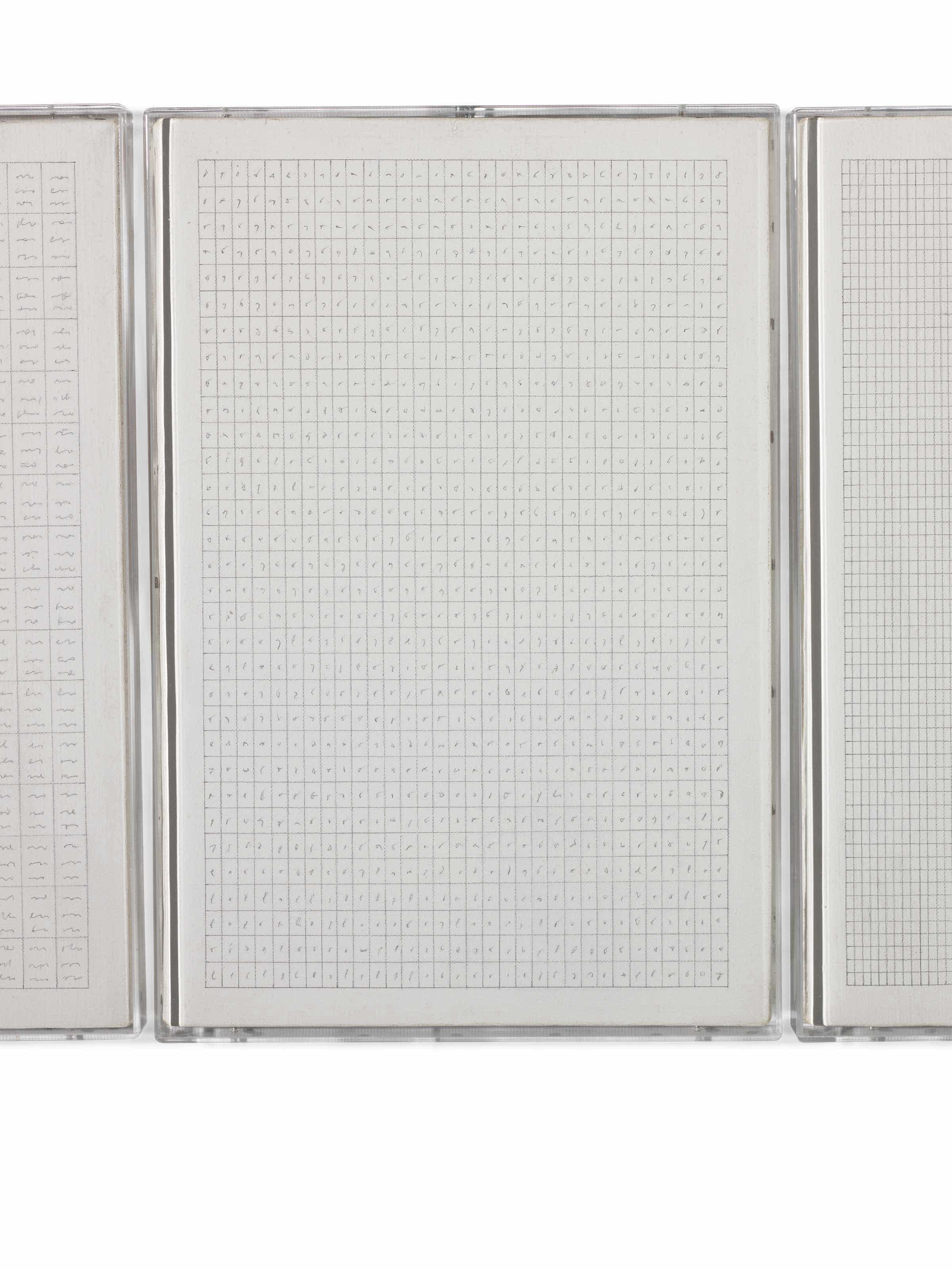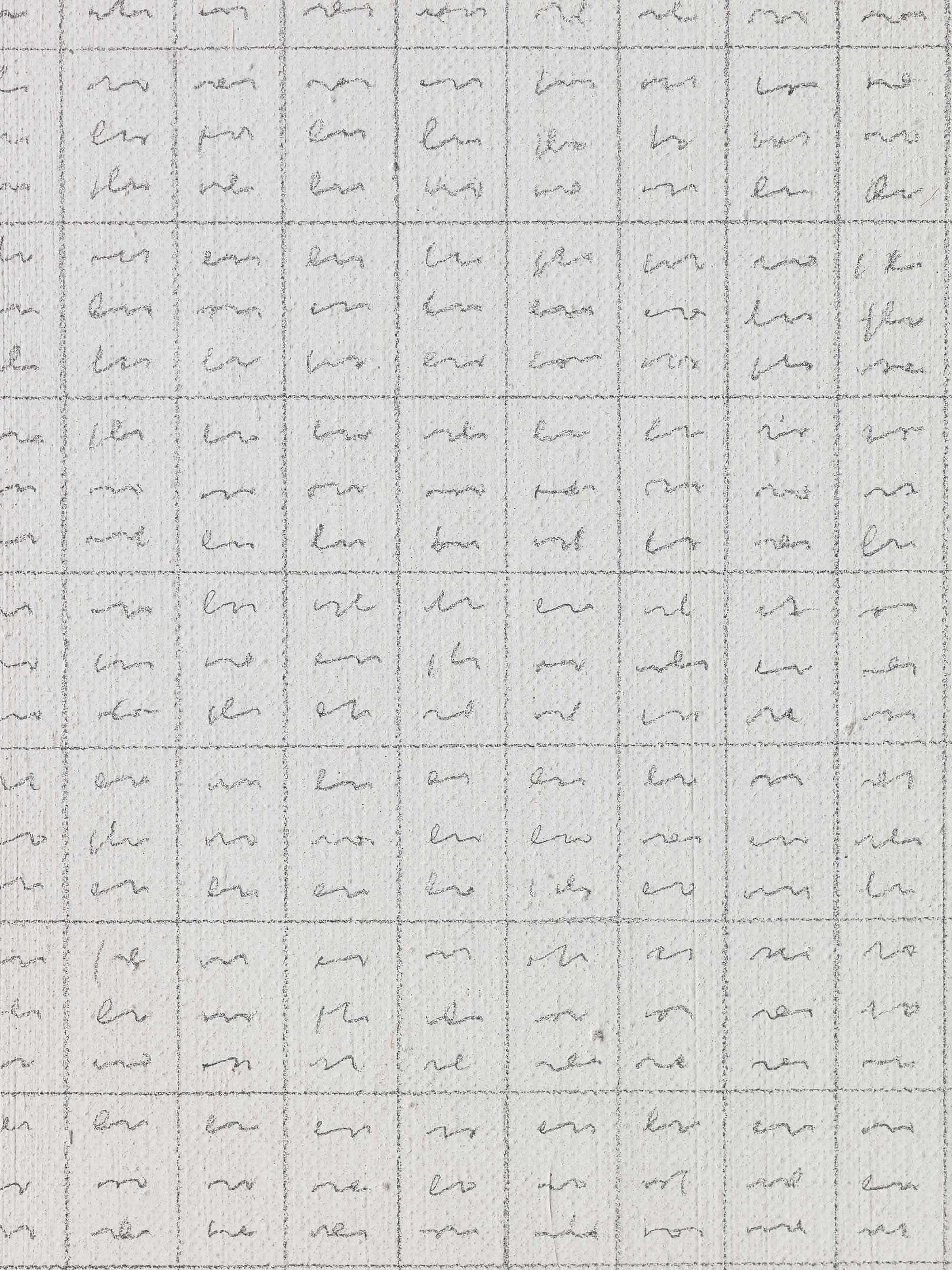Ennesima (appunti per la descrizione di sette tele datate 1973), 1973
GPO-0255
Umpteenth (Notes for the Description of Seven Canvases Dated 1973)
Pencil on primed canvas
Seven parts 45 x 30 cm each, overall dimensions 45 x 220 cm
Titled, signed, and dated on the verso of the first canvas, lower stretcher bar: “Ennesima / Giulio Paolini 1973”
Private collection, London
From one to the other of the seven canvases, a gradual reticular subdivision has the upper hand over automatic calligraphy – a hypothetical description of the work itself – ending up completely replacing the written image and appearing as a drawing.
In the artist's own words: “Hence, three elements: the writing, the image, time. Each of them, however, is exhausted in its own nominal enunciation and, all together, they cannot be seen as constitutive. Writing, overlooking any form of communication, preserves nothing other than its appearance, it describes nothing other than itself. The drawing is the extreme limit of its own legitimacy, the definition of the surface of the page. Time suggests the pattern and determines, via the succession of the two elements that reveal it, the enigmatic measure of the story: it subtracts further truthfulness from both the writing and the drawing, it regulates their co-penetration in a constantly variable identity, multipliable to infinity, but unalterable by fate. The first page is already the last one, the last one is still the first, the sequence moves from one equal towards an equal. Here, then, is the neutrality of a dynamic that, again via the use of the same elements, achieves none other than its own infinitesimal development. The title Ennesima [Umpteenth], in fact, is meant to recall the possibility of elevation ad infinitum of this process. As if to say that it is perhaps not so obvious to establish that the figurative, visual dimension, is born as a pure and simple image, and that it may instead have the implicit and intimate need to describe itself, the vocation to find another more definitive form of itself”.1
The theme of Ennesima was conceived in 1972-73 with several works on paper originating from the painting Appunti per la descrizione di un quadro datato 1972 (1972, GPO-0238). The theme was later developed into another variant on canvas (1975, GPO-0297), a print edition (1975, GPE-0017), and two further and more extensive versions on paper, made in 1987 (GPO-0628) and in 1988 (GPO-0625).
1 G. Paolini in Giulio Paolini. Atto unico in tre quadri, exhibition catalogue, Milan, Studio Marconi (Milan: Gabriele Mazzotta editore, 1979), p. 107.
| 1973 | Zurich, Galerie Annemarie Verna, Giulio Paolini, 19 October - 30 November. |
| 1985 | Esslingen am Neckar, Galerie der Stadt, Villa Merkel, Sein und Sehnsucht. 10 italienische Künstler der 60er und 70er Jahre, 19 July - 25 August, touring to: Kassel, Kunstverein Kassel, 5-30 October, cited in the checklist of exhibited works n. pag. (erroneously titled “Ennesima - appunti per la descrizione di sei disegni datati 1975” and dated “1975”), not repr. |
| 2015-16 | Milan, Triennale Milano, Ennesima. Una mostra di sette mostre sull’arte italiana, 25 November 2015 - 6 March 2016, vol. “Guida”: cited in the checklist of exhibited works p. 213, repr. p. 114 and on cover of the volume “Guida” (detail), catalogue entry by N. Ricciardi p. 115; vol. “L’immagine della scrittura: Gruppo 70, poesia visuale e ricerche verbo-visive”, repr. p. 19. |
| • | G. Paolini in Giulio Paolini. Atto unico in tre quadri, exhibition catalogue, Milan, Studio Marconi (Milan: Gabriele Mazzotta editore, 1979), pp. 106-107; republished in Giulio Paolini. La voce del pittore – Scritti e interviste 1965-1995, edited by M. Disch (Lugano: ADV Publishing House, 1995), p. 67. |
| • | M. Disch, Giulio Paolini. Catalogo ragionato 1960-1999, vol. 1 (Milan: Skira editore, 2008), cat. no. 255 pp. 266-267, repr. |





